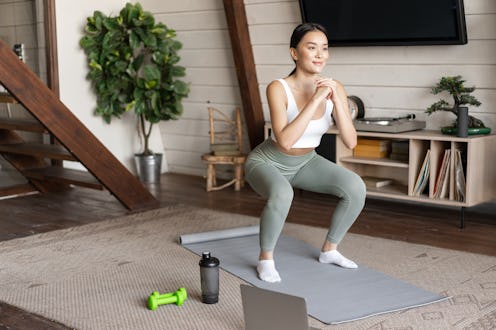
Traditional burpees seem to make an appearance in every cardio-based strength training routine (much to many people’s chagrin). If the goal is to work your entire body while getting your heart rate up, you can bet that your instructor will have you pop down into a push-up and then leap into the air. While the reverse burpee — aka the opposite of a burpee — isn’t as well-known, this move is just as beneficial when it comes to getting a cardio boost and targeting multiple muscle groups at once.
Otherwise known as an inverted burpee, reverse burpees can be a nice change of pace from the traditional technique, says Oscar Colon IV, a certified personal trainer and founder of fitness studio MTHD by Oscar. “Burpees typically involve moving from a standing position to a push-up position before hopping back into a standing position,” he tells Bustle. “By contrast, the reverse burpee has you quickly roll onto your back and into a crunch position before springing back onto your feet.”
While a traditional burpee is a full-body move that focuses on your core and shoulders — thanks to that push-up — a reverse burpee puts an extra emphasis on your glutes, hamstrings, and quads. But your core muscles will also experience a burn since you’re engaging them as you roll. “It uses momentum to target multiple muscle groups at once, including your lower body muscles,” Colon explains. It’s the motion of rolling from your back into a jump that really brings the burn.
Since they don’t require any equipment or a trip to the gym, Colon says it’s easy to incorporate reverse burpees into your at-home workout routine for a quick bodyweight workout. And just like traditional burpees, they’re also ideal for HIIT, or high-intensity interval training. Do a round of the exercise and you’ll be covered in sweat in no time. Here’s how to give the reverse burpee a try.
How To Do A Reverse Burpee
Here, Colon shares how to do a reverse burpee with good form so you can nail the heart rate-spiking move whenever you want to work your legs and core.
- Stand with your feet shoulder-width apart and a slight bend in your knees.
- Keep your shoulders directly over your hips with a neutral head and neck position, and your chin tucked throughout the movement.
- Evenly distribute your weight on both feet and “grip” the floor with your toes to create a stable position.
- Keep your arms long by your sides with a slight bend in your elbows.
- Take a deep breath and engage your shoulders, hips, and core.
- Bend your hips, knees, and ankles to lower yourself into a deep squat.
- In one fluid motion, lower yourself all the way to the ground and roll onto your back, bringing your knees to your chest.
- Roll until your upper back and shoulders touch the ground, then engage your abs to roll forward again.
- Use this momentum to quickly roll back to standing.
- As you begin to stand, explosively push through the ground to jump into the air.
- Straighten your legs and simultaneously swing your arms forward.
- At the top of the jump, your arms should be above your head and your legs should be straight.
- Land gently, squat down, and roll back again to repeat this motion.
- Begin with 2 to 3 sets of 5 of 10 repetitions twice a week and build from there.
How To Modify The Reverse Burpee
When doing a reverse burpee, focus on landing out of the jump with soft knees, Colon says. It’ll also help to keep your core engaged and your chin tucked the entire time so that you roll back safely and with control, which will help prevent muscle strains. (Note: If you’re too fatigued to roll with control, take a break.)
You can also make this move easier or harder, depending on what you’re in the mood for. “If the reverse burpee is too difficult, get your upper body involved by gently pushing off the ground with your hands before springing back onto your feet,” says Colon. “If you want to make it more challenging, build on the jump and take it up a notch with a tuck jump. By pulling the knees into the chest at the top of your jump, you’ll add even more explosion and intensity.” Consider it a choose-your-own-adventure, sweat edition.
Source:
Oscar Colon IV, certified personal trainer, founder of fitness studio MTHD by Oscar